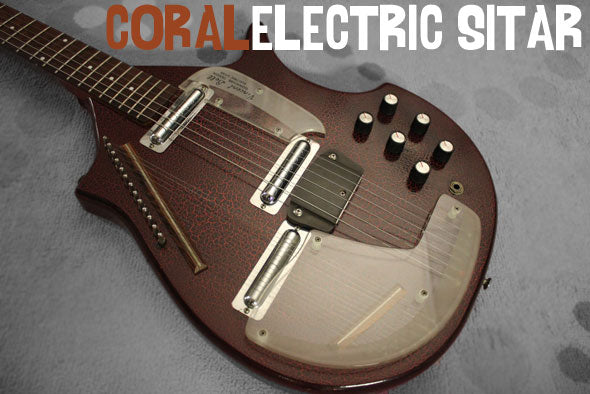AF110: The Coral Electric Sitar

Editor’s Note: Longtime readers of 20th Century Guitar will recognize the nom de plume G7 and his column “Anything For $1.10”. This infamous, hilarious, and enigmatic writer makes his return to writing about all things musical for themusiczoo.com. G7 will be a regular contributor to these pages and we are glad to have him.
The Coral Electric Sitar by G7
The most common guitar service problem is from players who feel that their guitars “buzz.” Only the 1960’s could have produced an instrument whose sole purpose was to buzz. Don’t have a spare lifetime to devote to the utter mastery of the Indian sitar like Ravi Shankar? Meet the Coral Electric Sitar. Haven’t seen one? It looks sort of like something Star Trek’s Mr. Spock would work out on after a rousing game of three dimensional chess. It has knobs and pickups and strings all over it but basically you just play it like a guitar. Well – sort of. You don’t want to be getting too frisky with this baby. You play pretty much one note at a time, ok? Does it sound like a real sitar? Wellll! Is it cool? Absolutely. You have heard them used often in a variety of music genres: Joe South’s “Games People Play”, The Stylistics’ “You Are Everything”, Paul Young’s ”Every time You Go Away” and many more. Steve Howe from Yes has been seen with one. Many session guitarists have one available just in case.
Vinnie Bell, a New York based session player developed the Electric Sitar for the Coral line from Danelectro mostly as a clever way to cash in on the “non cash” hippie culture. He also developed a simpler (no drone strings) sitar and an electric “Bellzouki” that were marketed under the Danelectro brand.
The “secret” to his sound was the “Sitarmatic” bridge (roll over Ravi). This was a large block of mystery material at the “bridge” end that the strings rested on. The rear edge of the block has a grooved metal strip that acted as a string guide. There was no actual bridge or tailpiece.Instead,there were small metal pegs that the ball ends of the strings hooked on to. The bridge block had three point height adjustment. Setting it to sitar (buzz) just right could create a serious need for transcendental meditation. Once the strings started to wear away the block you were no longer headed toward nirvana. Intonation was non-existent. Along the upper face of the instrument were 13 short “drone” strings tuned a half step apart. They had their own lipstick pickup and controls. The theory was that as you played across the neck these strings would vibrate sympathetically-a phenomenon I have yet to witness.
The overall construction of the Electric Sitar was fairly deluxe by Danelectro standards. The bodies, though hollow, appeared to be all wood without the usual masonite top and back. They were finished in a lurid black/red crackle color scheme. The necks had dual non-adjustable truss rods. All internal electronics were shielded in that Danelectro masking tape covered copper foil. Also typical of Danelectro, most of the ones you run across have all their parts still working fine. Boy, could those guys stretch a buck.
The instruments have proven to be durable collector pieces with clean original examples fetching in the low four figures although this has been dented somewhat by the arrival of the Jerry Jones version which includes nice features like an adjustable neck. But hey – real men wouldn’t think of playing a Telecaster with six bridge saddles. It’s trippy – it’s dippy – it’s at once bizarre and a hoot. Wait! I see the light!





